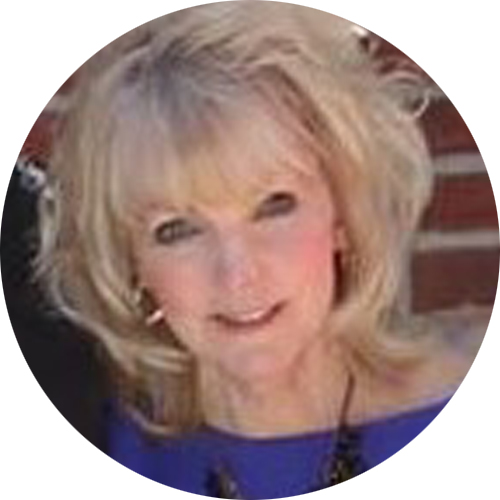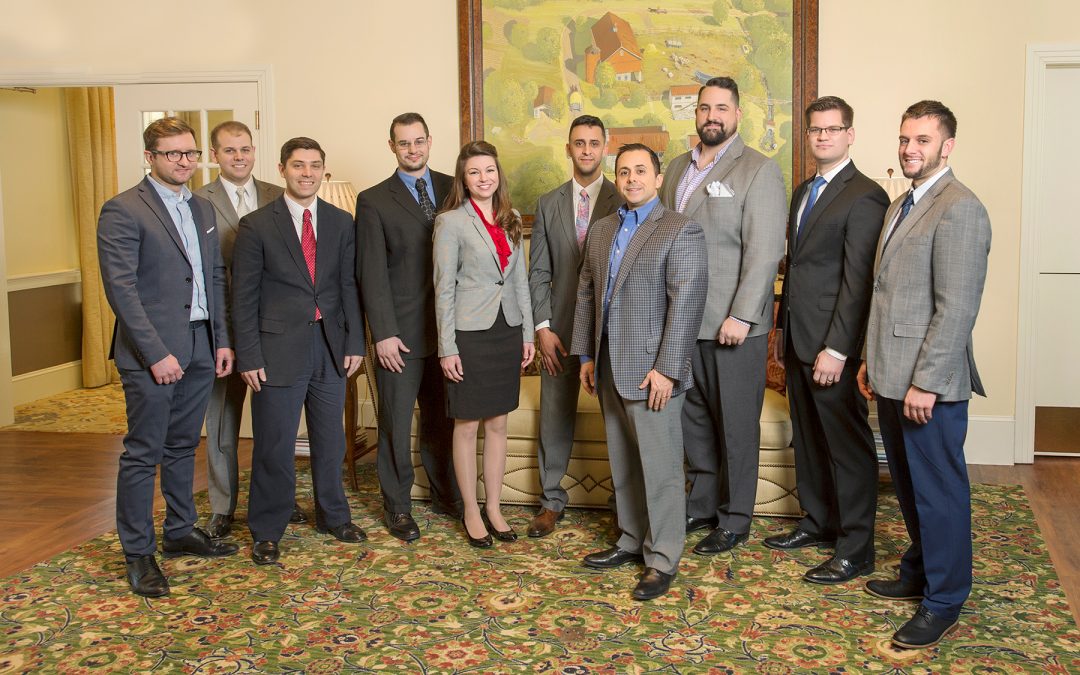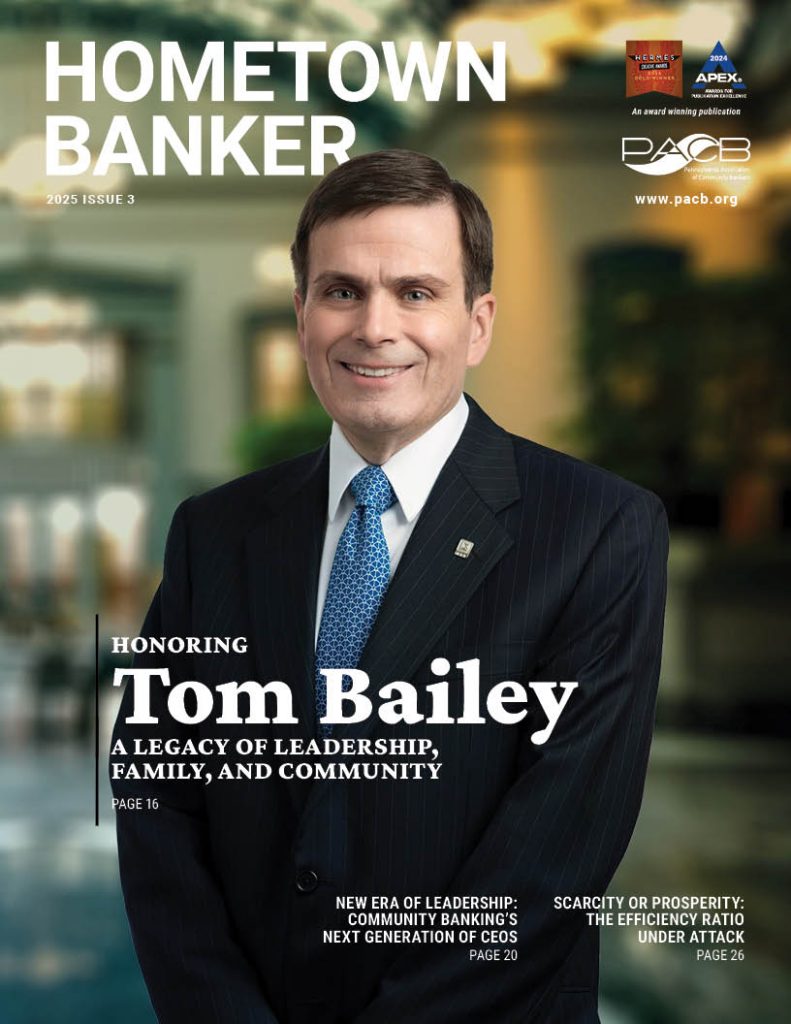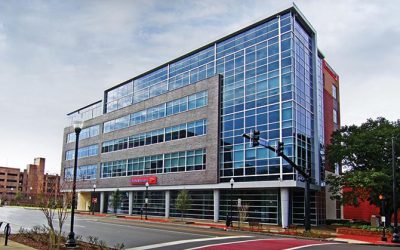By: Diane McNaughton
Mid Penn Bank, based in the forested hills and open cornfields of northern Dauphin County, is giving young professionals more bank for their buck by going straight to the source to track their likes and thumbs-downs.
Bank leaders see the writing on the branch wall: today’s millennials, born between 1980 and 2000, now comprise more than one in three workers in the work force and will balloon to half the work force by 2020. This powerful force, raised on Google, Starbucks, and instant gratification, is changing the face of banking.
Technology’s umbilical cord stretches into virtually every facet of a young professional’s personal and professional life. They look to their phone repeatedly every waking hour of the day for learning, laughter, networking and inspiration.
Alex Kauffman, a newly named president of Mid Penn’s western region who will soon be relocating with his young family to Pittsburgh, said young professionals like him are “the most under-served and most misunderstood segment” of the marketplace. To attract and retain them as both employees and customers, Kauffman and his fellow board members are seeking to “friend” them all.
To that end, two years ago, Mid Penn Bank President/CEO Rory Ritrievi launched the Young Professionals (YP) Advisory Board.
YP Board member Evan Dickinson of Mid Penn Bank saluted Kauffman and fellow Mid Penn employee Christyan DeVan for the board’s “marriage of people who are very smart and very involved.”
“Today’s Millenials….now comprise more than one in three workers in the work force”
Forward-thinking banks realize that it is a brave new world for a generation that spends an average of nine hours a day on social media–more than half their waking hours–and checks their phone more than 150 times a day. Email, Twitter, Instagram, Snapchat and Facebook are now a preferred avenue of communication for many, trumping face-to-face conversation or that staple of ‘60s and ‘70s office culture, the clunky, corded rotary-dial phone.
According to
the Bureau of Labor Statistics, the millennial generation is three times the
size of Generation X (people born between 1965 and 1980).
Determining what attracts and motivates this entire census block is an ongoing
challenge for every business, and one that Ritrievi decided to tackle head-on through
good, old-fashioned, face-to-face connectivity.
Instead of relying on research showing that millennials value purpose over a
paycheck, or that they seek flexibility over a 9-to-5 desk job, he opened the
door to an active exchange of ideas among many of central Pennsylvania’s
emerging young leaders.
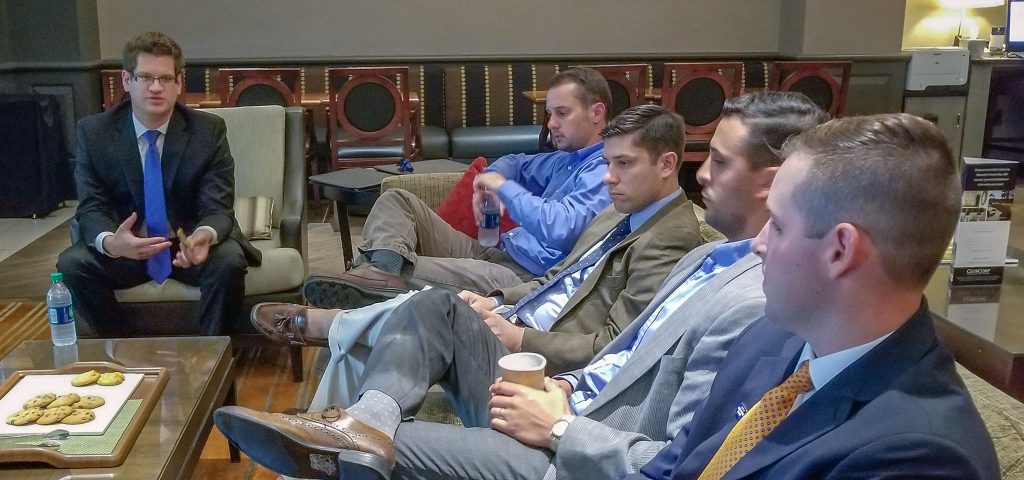
In a world where so many experts lament the pervasive “disconnection” in today’s family, friendships, workplace and community, Mid Penn Bank leaned in and built strong connections, both inside and outside the bank.
It was a perfect bridge between the past and the future for Ritrievi. Born at the very end of the baby boom generation, Ritrievi majored in economics at the University of Pittsburgh in the early ‘80s.
He went on to earn his law degree from Widener University School of Law in the 1990s, and remained on the “perpetual learning” path, even discovering marathon running in midlife.
As the father of three daughters, he prizes young professionals as not only employees, but as clients, family members and teachers.
Ritrievi makes sure that the advisory board not only talks; bank leaders listen. The group has become an idea factory and a GPS for the company. Many ideas are brand-new; others are relatively new but “accelerated,” DeVan said. Some ideas are killed at the outset as too costly or too faddish. Often, senior executives are invited in to hear the conversation.
The diverse, collaborative group has produced a big payoff. Many Mid Penn employees have developed stellar skills that would allow them to move anywhere, but they feel so valued that they wouldn’t dream of it.
Technology and social media often dominate the conversation in this highly collaborative board.
Ryan Albright, Marketing, Herbert Rowland and Grubic
The bank has also expanded its market share like an ink stain on satin and has built an impressive network of bright young twentysomethings and thirtysomethings in the community.
The Board is an effective fusion of classic and cutting-edge.
Established 150 years ago, in post-Civil War times, Mid Penn Bank is headquartered in northern Dauphin County, a land of rustic farms, tidy rowhouses, and vast open spaces, in a town that bears the mantra “smalltown perfection.” Despite its rich traditions and rural roots, the bank has learned to stay growing, vibrant, relevant and ultra-modern.
A seasoned banker, Ritrievi took the reins of Mid Penn Bank less than 10 years ago. He arrived in 2009, in the midst of the Great Recession and the political and cultural backlash against the big banks. Today, the bank has been hailed as “one of the best in the country,” and Ritrievi has been lauded for always staying ahead of new developments in banking and finance.
In recent years, Mid Penn has acquired several banks in both the western and eastern parts of the state. They bought the Malvern-based First Priority Financial Corporation and, before that, absorbed Minersville-based Phoenix Bancorp in 2015, parent of Miners Bank.
To empower the leaders of tomorrow now, Ritrievi recently adopted a new leadership structure, naming regional presidents in the four regions of Pennsylvania–including Kauffman–and establishing a foothold in the state’s anchor cities of Philadelphia and Pittsburgh.
Mid Penn now has over $2 billion in assets.
On a steamy afternoon in June, PACB CEO Nick DiFrancesco sat down with the advisory board members in the Harrisburg Hilton’s stately Hill Society room.
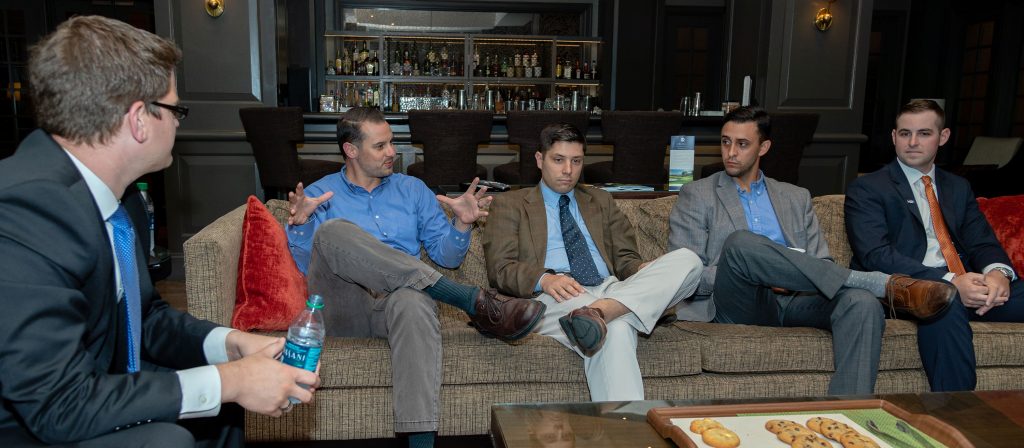
The core group included:
• Mike Eby, Senior Manager, McKonly Asbury
• Kevin Hall, Esq., Attorney, Tucker Arensburg
• Christyan Devan, Commercial Lending Division, Mid Penn Bank
• Alex Kauffman, Regional Vice President, Mid Penn Bank
• Evan Dickinson, Mid Penn Bank
“Rory is always a guy with vision,” Kauffman said.
Kauffman and DeVan put their heads together and formed a carefully selected, local brain trust in law, business, insurance, accounting, engineering, public relations, nonprofit management and commercial real estate.
Some advisory board members work for customers of Mid Penn; some do not.
The board meets quarterly for about two jam-packed hours a session, with follow-up in between. With a set agenda, developed by Ritrievi and the board, facilitators DeVan and Kauffman ask introspective questions, like “How do you want to bank?” “How do we get customers into our branches?” “What functions do young people want to perform on their phones?” and “What does our social media say about us?”
Technology and social media often dominate the conversation in this highly collaborative board.
According to Ryan Albright, a marketing expert at Herbert Rowland and Grubic, “We’ve provided input on new technologies Mid Penn Bank is looking to add, feedback on customer experiences both on the residential and commercial lending side, and act as a sounding board to the marketing messages they are promoting in their digital platforms, such as the Mid Penn Bank website, their social platforms, and other branding and communications channels.”
Alex Kauffman, Regional VP, Mid Penn Bank
“The board has helped the bank to “keep our same core values throughout our footprint”
Although Mid Penn has a powerful presence in Dauphin and Cumberland County, their technology solutions will allow them to transcend geography and reach and serve bank customers virtually anywhere, the group noted.
The board has helped the bank to “keep our same core values throughout our footprint,” Kauffman said.
The board is not formally linked to the community-based West Shore Young Professionals or the Harrisburg Young Professionals, but many members belong to one of these organizations, including Ivy Schneider of Helix Strategies, who founded the West Shore Young Professionals.
Board members embrace and live out the community bank difference.
Community banks are “more local, more consumer-driven, community-driven, hands-on,” YP board member and Landmark commercial realtor and senior associate Drew Bobincheck said.
Fellow board member and Deloitte attorney Jean Cho Mosley said, “A community bank actively seeks to offer a customer experience fine-tuned to the needs of its surroundings. The bank does not have to adhere to the overhead operating standards of a large corporate bank who might not have direct contact with the community it serves.”
Banking has changed, DiFrancesco acknowledged. In the old days, bankers sat in their bank, and said, “I have the money. If you need it, come and get it.” Not now. The bank must be reaching out into the community everywhere and in any way it can.
The board’s byproduct is reflected in their success in recruiting new employees, retaining rising stars, cultivating new businesses, and identifying new leaders in the community.
The board “gives instant feedback on improving or rejecting an idea,” Kauffman said.
The group works often with the bank’s director of IT, who is himself a millennial, in developing mobile apps and other high-tech solutions.
Hall lauded the community involvement and networking the group engenders, giving him the ability to mingle with senior board members of other companies.
“The first impression in that bank is pretty important”
Alex Kauffman, Regional VP, Mid Penn Bank
Eby agreed. “I am on many nonprofit boards but, at this stage of my career, I don’t often get asked to be on many for-profit boards.” The advisory board opened the door.
Kauffman enjoys talking about customer service with YP-ers.
He said, “I’m intrigued by that branch experience.”
Most young people don’t visit a bank branch when they need to execute a transaction. But when they have a major life decision to make, like, “Do I take out a big loan for my house, business or graduate degree?” they do indeed venture inside a branch office. They want that face-to-face dialogue and that human interaction.
Eby agreed. For larger cash deposits, they will go into a brick and mortar branch, he acknowledged.
Because branch visits are infrequent, “The first impression in that bank is pretty important,” Kauffman affirmed.
The board has also helped with marketing of the bank through social media and recently helped to overhaul the website.
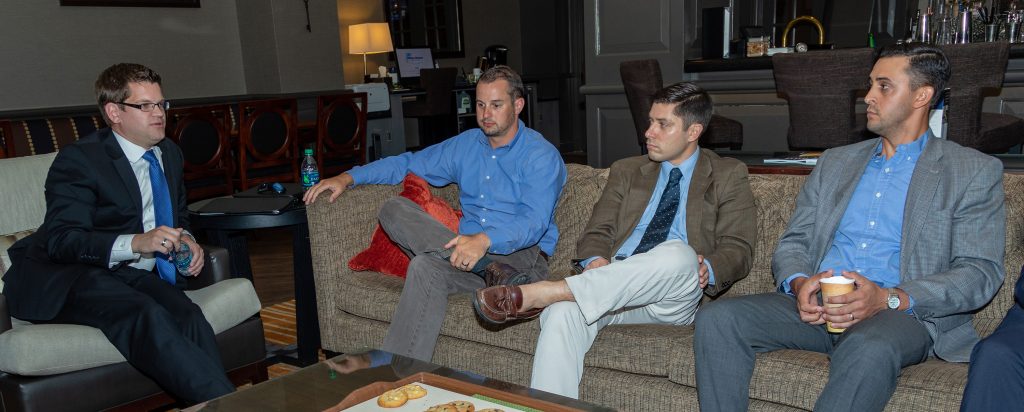
Hall said, “Folks want a community feel.” They want a brick and mortar at times, to bring people in and build relationships.
DiFrancesco talked about innovative ways banks can use their physical space, like hosting wine-tastings and corporate mixers.
Kauffman said the bank does host local networking events, bringing in local restaurants, serving cookies, and using their branches in new and innovative ways.
Because apps entice people to not join in a face-to-face community, banks need to develop these and other ways to still connect.
Even though the bank is expanding at lightning speed, Mid Penn still has a “community feel,” said Hall.
Kauffman confirmed that the young board does not exist in a vacuum. Senior bank executives often visit the meetings, and bring their analog perspective to a digital-savvy world.
Not all ideas are given the green light. Trendy new “toys” and tech ideas have been turned down, avoiding a costly investment of limited resources in the latest “it” thing.
Through the group, Mid Penn bolstered their call center and online support center, and included these endeavors in the Strategic Plan.
“Millenials view finances and money in a much more integrated way”
Kevin Hall, Esq., Attorney, Tucker Arensburg
DiFrancesco underscored, “The bank is listening.”
Kauffman confirmed that the group provides regular updates to Rory, and he is very supportive of items discussed to take action very quickly as needed.
The group not only develops technology, but examined how the banks communicate that this bonanza of new technology is available.
Kauffman said today’s young professionals “are very savvy customers.” They have more information at their fingertips than ever before, and they know how to find it and apply it. They always are going online, allowing them to assess what other banks are offering and doing. They do their homework; they know rates and competing offers.
Hall said, “Millennials view finances and money in a much more integrated way.”
Unlike his parents and grandparents, “I don’t view money as ‘at the bank’ anymore. It’s a figure on a laptop or a phone. How does it seamlessly integrate across multiple platforms?”
Choosing a bank does not just come down to who has the best rates, the young leaders said. Most youthful investors truly care about who has a social conscience and a community vibe.
Apps–coupled with a local connection–are that visceral “thing” they search for.
Grandparents used the same bank for their home loans, car loans, and savings decades ago.
Now, customers go online, and banks compete virtually for customers. Younger people admitted they find outside banks harder to deal with.
Hall said, “Maybe a large percentage of the market offers a better rate and cares about making a buck, but is this the market community banks are after?” he asked rhetorically. “Probably not.”
“That’s our sweet spot.”
Big banks come in and don’t care about relationships, he noted from his vantage point as both a consumer and an attorney.
Eby echoed the sentiments of many on the board when he said the advisory board “provides a great opportunity to inform a bank I’m involved with as a customer.”
DeVan said, “We try to come up with topics that allow us to continue to grow, and attain a younger clientele.”
Dickinson said, “This helps us connect with future community leaders. These are people who will be leaders in five or ten years.”
Albright said an understanding of the financials is key to any business leader. “Involvement with the board allows me to see the inner workings of the financial industry that I otherwise wouldn’t be exposed to. It has also connected me with professionals in similar roles to my own that I can lean on for guidance in my position. I’ve already collaborated with the marketing team at Mid Penn Bank to exchange best practices on the challenges I face on a daily basis even though we work in totally different industries.”
They support each other, helping with such nonprofit groups as Habitat for Humanity, Ronald McDonald House, animal rescue, cancer awareness, and college scholarships.
Kauffman said, “I’ve been inspired by Mid Penn, and under Rory’s leadership, we are growing by leaps and bounds.”
“It’s so important to look at our weaknesses as we grow,” in an effort to better serve every customer and industry in all of their communities.
This advisory board promises to steer a clear path to the next 150 years, and to bring future generations with them for the ride.
Albright encapsulated the virtues of Mid Penn, the YP Board, and the industry as a whole: “As a community bank, they give back to their community and are vested in the positive economic development of the communities they work in. When the community does well, they do well and everybody wins.”

